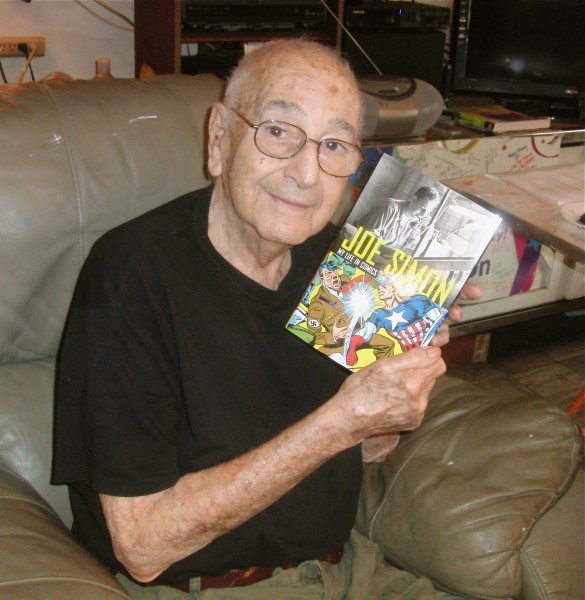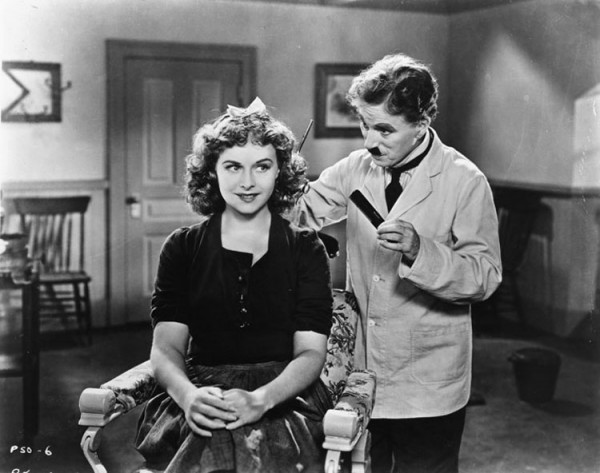
Joe Simon shows off his colorful autobiography in his New York City apartment (photo by twi-ny/mdr)
JOE SIMON: MY LIFE IN COMICS (Titan, June 2011, $24.95)
www.titanbooks.com
The potential summer blockbuster Captain America opens in theaters today, but that would not have been possible without Joe Simon. Back in 1941, Simon, a native New Yorker born and raised in Rochester, teamed up with Jacob Kurtzberg, better known as Jack Kirby, and created the red, white, and blue superhero. The villain for the cover of the first issue? They came up with just the right one. “Adolf Hitler would be the perfect foil for our next new character, what with his hair and that stupid-looking moustache and his goose-stepping. He was like a cartoon anyway,” Simon writes in his entertaining, intimate, and refreshingly honest memoir, My Life in Comics (Titan, June 2011, $24.95). “We knew what was happening in Europe, and we were outraged by the Nazis — totally outraged. We thought it was a good time for a patriotic hero. . . . And that’s how Captain America was created.”
Today the ninety-seven-year-old Simon spends most of his time in his cluttered apartment just west of the Theater District, surrounded by classic drawings, sketches, and comic book covers. His works line the walls, a veritable history of the industry in black and white and color. One of the many highlights is a grand depiction of the Last Supper populated with his characters, a painting he completed with his daughter Gail. Sitting in his large, comfortable recliner in the middle of the living room, Simon is thrilled to tell tales of his days serving in the Coast Guard with Jack Dempsey, meeting Damon Runyon and Max Baer while a journalist, riding horses in Forest Park, and mentoring such comic book legends as Stan Lee. As we talk, he pulls out stunning works accumulated from throughout his fascinating career. He pauses to congratulate one of his granddaughters for passing an important college test; seven of his eight grandkids were scheduled to fly to Hollywood to walk the red carpet at the star-studded Captain America premiere. Among the other characters Simon had a hand in either creating or developing were the Fiery Mask, the Fly, the Blue Bolt, Sandman, the Newsboy Legion, Manhunter, and the Boy Commandos. An engaging character himself with a sharp memory and a wicked sense of humor, Simon discussed his book and life with twi-ny shortly before the release of the Captain America movie.

twi-ny: What was the experience like going through your past to put together My Life in Comics? Were there any particular parts of your life that were more difficult to talk about than others?
Joe Simon: This was the first time I revealed some of the more intimate details of my life, talking about my wife Harriet and my family, and some of the challenges we’ve faced. It wasn’t really difficult, but it was something I’d never really talked about before.
I feel very lucky because I have my memory. There are things that happened to me ninety years ago — such as the time I met a Civil War veteran — which I remember clearly. I’ve had a lot of exciting things happen to me over the course of ninety-seven years, and it was wonderful to be able to get them down on paper, for everyone to experience.
twi-ny: In the book, you note that you and many of your earliest colleagues come from immigrant Jewish families working in the clothing business in New York City. Do you think that might have had some impact on your eventual career path, creating superheroes and villains dressed in fairy-tale costumes?
JS: That’s a good question. Since tailoring involves creativity, I suppose my parents influenced me in that way, and I’d never really realized it. They also influenced me with their attempts at true romance writing, as badly as they turned out, and with the sense that you stick to it, no matter what you’re trying to accomplish. So in both of those ways they helped me throughout my career. (And of course, thanks to my father, when I came to New York City, I was the best-dressed guy in the comic book business.)
twi-ny: The Captain America movie comes out on July 22. What was your involvement with the picture? What are your thoughts about the film, and about superhero movies in general as they continually get transferred from comic books to the big screen?
JS: Stephen Broussard at Marvel Studios has been keeping me up-to-date, and he arranged for them to film an interview with me. I’ve been liking everything I’ve seen, and am very excited to see how it turns out.
I haven’t seen all of the superhero movies, especially in recent years, but I understand that the Marvel films have been very good. I’ve always thought that Captain America would make a terrific movie and could never understand why all of the earlier attempts sucked so badly. This time, though, they’re sticking to the story that Jack Kirby and I created, so I think they’ll get it right. That’s always the best way to do it — stick with what works.
[Joe Simon: My Life in Comics is available through Amazon and in bookstores everywhere.]


 Learning of many of the horrible things the Third Reich was doing, Charlie Chaplin could not hold his tongue anymore, finally making his first talking picture in 1940. In The Great Dictator, writer-director-producer Chaplin unrelentingly mocks Adolf Hitler and the rise of the Nazis in Germany, albeit with a very serious edge, as WWII threatens. Chaplin plays the dual roles of a simple Jewish barber living in the ghetto (who has elements of the Little Tramp) and Adenoid Hinkle, the rather Hitler-esque Fascist leader of the country of Tomania. Just as he named the nation after a foodborne illness (ptomaine poisoning), Chaplin does not go for subtlety in the film; his right-hand man is Herr Garbitsch (Henry Daniel spoofing Nazi Minister of Propaganda Joseph Goebbels), and his military mastermind is Field Marshal Herring (Billy Gilbert making fun of Heinrich Himmler). Chaplin plays Hinkle like a cartoon character, with pratfalls galore, and when he speaks in German, especially when he gives a major speech, he spits out fake German words with a smattering of funny English ones. When he learns that Benzino Napaloni (Jack Oakie as a melding of Benito Mussolini and Napoleon Bonaparte) has gathered his troops on the Osterlitz border (think Anschluss), Hinkle invites the Bacteria dictator to his Tomanian palace, where they engage in numerous hysterical bouts of one-upmanship, including a riotous battle involving barber chairs. Meanwhile, Chaplin performs another of the film’s most memorable scenes, the shave of an old man set to Brahms’s “Hungarian Dance No. 5.” But when Commander Schultz (Reginald Gardiner) leaves the Nazi regime and decides to help the Jewish people in the ghetto, Hinkle sends his stormtroopers out to find the traitor, leading to a major case of mistaken identity and a heartfelt, if overly melodramatic, finale. In addition, Chaplin’s lover at the time, Paulette Goddard, plays Hannah (named for Chaplin’s mother), a young Jewish woman living in the ghetto, and Bowery Boys fans will recognize Bernard Gorcey, who played sweet-shop owner Louie Dombrowski in the goofy film series, as Mr. Mann.The Great Dictator is filled with marvelous moments, from Hinkle dancing with a balloon globe to several of the Jews in the ghetto trying to hide in the same chest, but the film does suffer from pedagoguery in making its political points, and some of the slapstick is too lowbrow. Nominated for five Oscars, it falls somewhere between the Marx Brothers’ Duck Soup (1933) and the Three Stooges’ You Nazty Spy! (1940) while also referencing the 1921 silent film King, Queen, Joker, in which Chaplin’s older half-brother, Sidney (who also directed), played the dual role of a modest barber and the king of the fictional Coronia. A seminal achievement that was supposedly seen by Hitler twice, The Great Dictator is screening on August 21 as part of Symphony Space’s “Chaplin” series, which is presenting many of his works on the big screen in HD for the first time ever; the series continues with such films as
Learning of many of the horrible things the Third Reich was doing, Charlie Chaplin could not hold his tongue anymore, finally making his first talking picture in 1940. In The Great Dictator, writer-director-producer Chaplin unrelentingly mocks Adolf Hitler and the rise of the Nazis in Germany, albeit with a very serious edge, as WWII threatens. Chaplin plays the dual roles of a simple Jewish barber living in the ghetto (who has elements of the Little Tramp) and Adenoid Hinkle, the rather Hitler-esque Fascist leader of the country of Tomania. Just as he named the nation after a foodborne illness (ptomaine poisoning), Chaplin does not go for subtlety in the film; his right-hand man is Herr Garbitsch (Henry Daniel spoofing Nazi Minister of Propaganda Joseph Goebbels), and his military mastermind is Field Marshal Herring (Billy Gilbert making fun of Heinrich Himmler). Chaplin plays Hinkle like a cartoon character, with pratfalls galore, and when he speaks in German, especially when he gives a major speech, he spits out fake German words with a smattering of funny English ones. When he learns that Benzino Napaloni (Jack Oakie as a melding of Benito Mussolini and Napoleon Bonaparte) has gathered his troops on the Osterlitz border (think Anschluss), Hinkle invites the Bacteria dictator to his Tomanian palace, where they engage in numerous hysterical bouts of one-upmanship, including a riotous battle involving barber chairs. Meanwhile, Chaplin performs another of the film’s most memorable scenes, the shave of an old man set to Brahms’s “Hungarian Dance No. 5.” But when Commander Schultz (Reginald Gardiner) leaves the Nazi regime and decides to help the Jewish people in the ghetto, Hinkle sends his stormtroopers out to find the traitor, leading to a major case of mistaken identity and a heartfelt, if overly melodramatic, finale. In addition, Chaplin’s lover at the time, Paulette Goddard, plays Hannah (named for Chaplin’s mother), a young Jewish woman living in the ghetto, and Bowery Boys fans will recognize Bernard Gorcey, who played sweet-shop owner Louie Dombrowski in the goofy film series, as Mr. Mann.The Great Dictator is filled with marvelous moments, from Hinkle dancing with a balloon globe to several of the Jews in the ghetto trying to hide in the same chest, but the film does suffer from pedagoguery in making its political points, and some of the slapstick is too lowbrow. Nominated for five Oscars, it falls somewhere between the Marx Brothers’ Duck Soup (1933) and the Three Stooges’ You Nazty Spy! (1940) while also referencing the 1921 silent film King, Queen, Joker, in which Chaplin’s older half-brother, Sidney (who also directed), played the dual role of a modest barber and the king of the fictional Coronia. A seminal achievement that was supposedly seen by Hitler twice, The Great Dictator is screening on August 21 as part of Symphony Space’s “Chaplin” series, which is presenting many of his works on the big screen in HD for the first time ever; the series continues with such films as 
